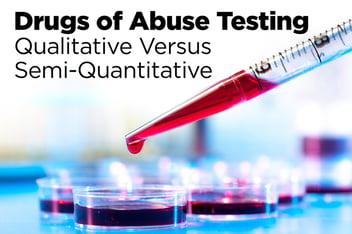Diagnostic tests have become increasingly important around the world as the first line of defense against the spread of disease. POC testing can help to optimize treatment decision-making, avoid referrals, and improve the efficiency of care and decrease costs.1

In vitro diagnostics (IVDs) are tests that can detect disease, conditions, and infections, enabling doctors to effectively diagnose patients and provide appropriate treatments. These tests are typically conducted in glass test tubes (in vitro means “in glass”), and can be done in laboratories, healthcare facilities, or even at home. They can be performed on a variety of instruments, ranging from small, handheld tests to complex lab instruments.2
It’s estimated that there are over 40,000 products available for IVD testing, covering a wide range of conditions, including lab-based, point-of-care, and point-of-patient care tests.3
Because these tests are relied on so heavily, there needs to be strict quality control measures to ensure their safety and efficacy. The FDA classifies all medical devices – including IVD products – as either Class I, Class II, or Class II. The classification will vary based on the risk involved and the level of regulatory control needed to guarantee the safety of the product. Class I products are considered low to moderate risk and require general controls, Class II products are considered moderate to high risk and require general controls and Special Controls, Class III products are considered high risk and require general controls and Premarket Approval (PMA).4
In this blog, we will explore the key components of quality control in IVD manufacturing, the importance of regulatory compliance, and the impact of emerging technologies on maintaining product safety and efficacy.
What is Quality Control in IVD Manufacturing?
Implementing quality control processes in IVD manufacturing is the best way to ensure that manufacturers are meeting the regulatory requirements. Manufacturers of IVD medical devices often include quality control procedures in their instructions for use, aiming to provide users with the assurance that the device is performing within those specifications and the results are suitable for the intended use. For some devices, QC procedures are an essential risk control measure.5
All medical devices, IVDs included, are subject to General Controls. General Controls are the basic provisions of the May 28, 1976 Medical Device Amendments to the FD&C Act, that provide the FDA with the means of regulating devices to reasonably assure their safety and effectiveness, applying to all medical devices and IVDs.6
Most manufacturers and distributors will voluntarily recall products that present a risk of injury or defect, and the FDA will issue recall orders in the event that the manufacturers and distributors don’t.7
As IVD manufacturing continues to evolve, global regulatory requirements will become more commonplace.
Future Trends in Quality Control for IVD Manufacturing
As IVD manufacturing continues to evolve, global regulatory requirements will become more commonplace. In 2020, the European Union introduced a regulations legislation that was designed to create a robust, transparent, and sustainable regulatory framework, recognized internationally, that improves clinical safety and creates fair market access for manufacturers.
In terms of their impact on manufacturers and products, the IVD Directive and the IVD Regulation largely share the same basic regulatory process. No existing requirements have been removed, but the IVDR adds new requirements. The IVDR brings more stringent requirements for the designation of Notified Bodies, with increased control and monitoring by the national competent authorities and the Commission. The biggest change concerns the risk classification of IVD devices. The IVDR also clarifies the obligations of economic operators (manufacturers, authorized representatives, importers and distributors).8
Because of the role they play in the healthcare continuum, the accuracy of your IVD products is paramount to taking care of the patient. With heightened quality control procedures, you can ensure the accuracy of your IVD product for any diagnostic testing your team has to do. SEKISUI Diagnostics are suppliers of high-quality materials for a variety of diagnostic applications, and we are committed to assuring a sustainable supply chain and business continuity for our customers.
References
- In vitro diagnostics, World Health Organization
- In vitro diagnostics, World Health Organization
- What Are In Vitro Diagnostics and Why Are They Important?, Biomérieux
- In Vitro Diagnostics, Scilife
- Clinical laboratory medicine — In vitro diagnostic medical devices — Validation of user quality control procedures by the manufacturer, iso.org
- Overview of IVD Regulation, FDA
- Overview of IVD Regulation, FDA
- Factsheet for Manufacturers of in vitro diagnostic medical devices, European Commission
.jpg?width=352&name=A%20clean%20professional%20(1).jpg)


Share Article